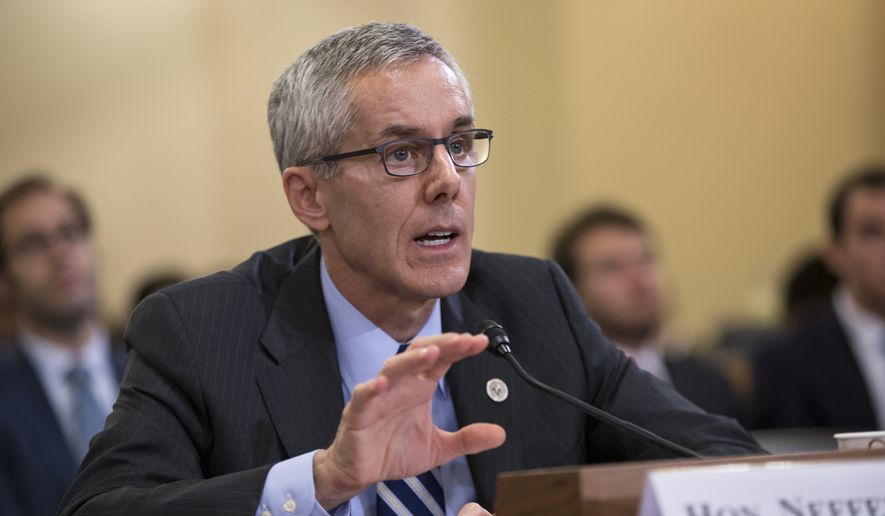The head of the Transportation Security Administration highlighted a bright spot in its ongoing struggle to reduce wait times for airline passengers — nearly all passengers flying over Memorial Day weekend made it through security lines in under 30 minutes.
TSA Administrator Peter Neffenger, testifying before the Senate Homeland Security and Governmental Affairs Committee on Tuesday, said 99 percent of the 10.3 million passengers who traveled over a six-day period around Memorial Day weekend waited less than 30 minutes in security lines. Ninety-three percent of passengers made it through lines in under 15 minutes, he said.
The achievement was much-needed positive news for an agency that has struggled with public criticism as wait times at airlines spiraled out of control earlier this year — resulting in horror stories of hourslong waits and hundreds of missed flights at airports around the country.
Mr. Neffenger highlighted several of the initiatives that the TSA has undertaken to grapple with the expected surge of airline passengers over the summer travel season — among them a closer focus on monitoring of security lines and resources, including the deployment of canine teams, at the top 20 busiest airports.
“When you get the stories of long wait times, it’s there,” Mr. Neffenger said of the largest 20 airports, which handle approximately 58 percent of daily traffic. “The positive side is if you can work on those 20 airports, you can really, for the most part, solve the problems in the whole system.”
The TSA is increasing staffing during peak times at the nation’s busiest airports, increasing overtime for part-time workers and redeploying employees to new locations when their current assignments are not in the midst of peak traffic times.
The agency also established a National Incident Command Center that monitors real-time daily screening operations in order to rapidly adjust the number of officers and resources to locations ahead of anticipated traffic surges.
In the case of long wait times that resulted in more than 450 people missing flights at Chicago’s O’Hare International Airport in May, Mr. Neffenger said the problem was “a failure to get enough lanes open in anticipation of increased volume.”
“Once you are behind, it is very challenging to catch up,” he said.
Another area already demonstrating the ability to increase efficiency at security screening lines is the development of “innovation lanes,” which recently debuted in Atlanta.
Two new lanes, developed by Delta Air Lines, speed up wait times in security lines by providing five divestment points — or spots where passengers would empty their pockets and place their carry-on bags on conveyor belt scanners. The system allows for items that trigger an alarm to be diverted to a separate area for inspection, rather than holding up the entire line while one person’s belongings are searched.
In the time since the automated innovation lanes were opened at the Atlanta airport in May, Mr. Neffenger said they’ve already reported a 30 percent increase in efficiency. The TSA is looking into opportunities to use innovation lanes at three other airports.
Despite the goal to add 768 new screeners to the employee roster by June 15, Mr. Neffenger said he still believes the agency needs to continue to add staff. “I do think TSA is smaller than it needs to be to handle the volume in the system,” he said.
More than 742 million airline passengers are expected to fly in the U.S. this year.
The latest initiatives to improve passenger wait times, while maintaining a high standard for security screening, follow a series of reports by the Department of Homeland Security’s inspector general that highlighted vulnerabilities in the TSA’s screening process.
“TSA is now, for the first time in memory, critically assessing its deficiencies in an honest and objective light,” Inspector General John Roth told the committee Tuesday.
During Tuesday’s hearing, lawmakers expressed support of the initiatives that the TSA has launched since Mr. Neffenger was appointed to head the agency last summer and asked what else Congress could do to support security reforms.
“Congress must work with the administration to ensure that the agency has the resources it needs to effectively carry out its mission,” said Sen. Thomas R. Carper, Delaware Democrat and the committee’s ranking member. “Funding levels in appropriations bills awaiting action in the Senate move us — and TSA — in the right direction. We need to enact them.”
Senators also offered up their own experiences in airport security lines as fodder to probe TSA management decisions.
“Why are there so many people who don’t seem to have anything to do at the checkpoint line?” asked Sen. Michael B. Enzi, Wyoming Republican.
Mr. Enzi suggested the TSA move seemingly unoccupied workers out of sight of passengers stuck waiting in security lines so as not to exacerbate their frustrations.
Sen. Ron Johnson, head of the Homeland Security Committee, expressed frustration that one of the tools TSA uses to speed up wait times — the TSA Precheck program — has been unable to enroll new passengers in some states due to delays in the application approval process.
“Wisconsin is one of two states in the country where enrollment centers are fully booked, forcing Wisconsinites to wait 45 days for an appointment,” the Wisconsin Republican said. “This delay is entirely avoidable, as 200 additional enrollment adjudicators stand ready to work, but are awaiting final TSA approval.
If the TSA would act on these applications, wait times for Precheck would likely immediately go down.
Mr. Neffenger said the agency has the ability to process a completed Precheck application within seven days, and promised to look into what was causing the specific delays in Wisconsin.
• Andrea Noble can be reached at anoble@washingtontimes.com.




Please read our comment policy before commenting.